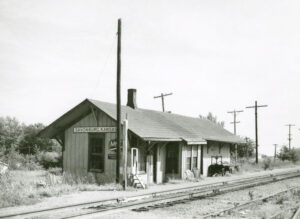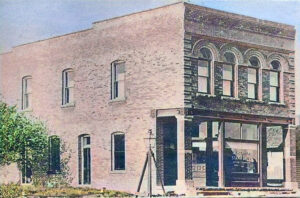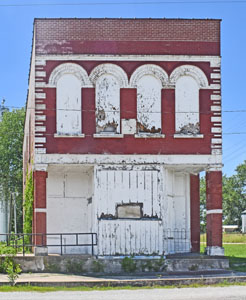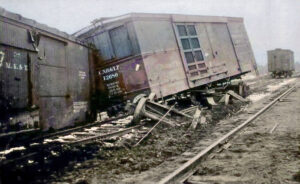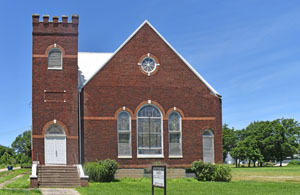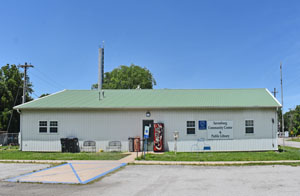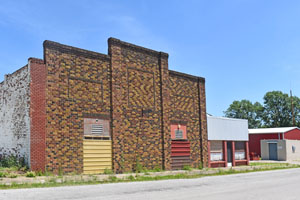
Savonburg, Kansas Main Street, courtesy Google Maps.
Savonburg, Kansas, is an unincorporated small town in Elsmore Township in the southeast corner of Allen County. It is also “officially” extinct, as it no longer has a post office. As of the 2020 census, its population was 74, and its total area was 0.20 square miles, all land.
The town was founded in 1879, and many of its first settlers were Swedish. A post office was established on May 21, 1879, with John Keen as the postmaster. He was also the first merchant to keep a store until 1881 when A. Linville succeeded him. In 1883, Mr. Linville sold out to L.B. Murray, who continued the business until 1888. In the early spring of that year, Charles Nelson, who was destined to play an important part in the building of the town, rented the business room of L.B. Murray and, in the early part of May, removed from Warnersburg, a school district three miles west, about one-half of his stock of general merchandise. Nelson enjoyed a good business from the start, which was significantly increased by the patronage of the laborers engaged in the building of the Kansas City, Parsons & Pacific Railroad, later known as the Missouri, Kansas & Texas Railway, which was completed to this point in August.
At about this time, a corps of engineers surveyed a route for the Kansas, Nebraska & Western Railroad, which was at that time the construction company of the Atchison, Topeka & Santa Fe Railroad, the line of the definite location being some 600 feet south of Main Street. The engineers were soon followed by an agent, who came to secure the right of way and land for a townsite, and options were obtained upon 240 acres. Shortly after, the Santa Fe Railroad encountered financial issues, which terminated in a receivership for the company, and the project came to naught. In March 1889, the options which the company had secured expired.
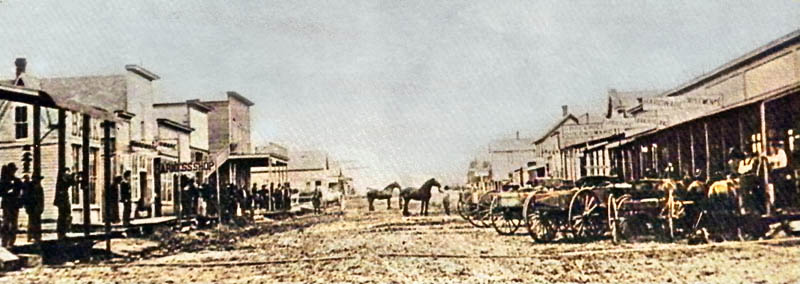
Savonburg, Kansas, late 1800s.
The people of the vicinity then determined that it would be advisable to organize a town company and proceed to the town’s building. Accordingly, a charter was procured, and on March 24, 1889, the Savonburg Town and Improvement Company formally opened for business, with an authorized capital of $25,000, under the direction of Charles Nelson, president; R.G. Cravens, vice president; L.B. Murray, Secretary: and J.T. Butterfield, treasurer, with a Board of Directors.
Within no time, 25 acres were purchased and platted, and money was raised to erect three business rooms. Charles Nelson then sold his stock of merchandise to D W. Craddock and, upon request of the Town Company, and consented to give his time and energy to promote the newly platted village.
One of the principal difficulties initially was the lack of a depot and other railroad facilities. At that time, only a small platform measuring 8×20 feet alongside the main track and a 400-foot-long spur switch had been provided, allowing rival towns to assert that they had better railway facilities.
In March 1890, Charles Nelson, on behalf of the townspeople, filed a complaint to the State Board of Railroad Commissioners against the Missouri, Kansas & Texas Railway, the representatives who were cited to appear and show cause why they should not be compelled to provide the needed facilities. After it was shown that for eight months previous, the company’s receipts at this place were $1,000 and over per month, the railroad wisely decided to erect a depot, stockyards, and switch. In the next decade, the town earned the well-merited reputation of being one of the best shipping points in the division.
Soon, Savonburg advanced from an insignificant hamlet to a substantial country town of about 300 people, which was remarkable for her business interests, particularly as a shipping point for livestock, grain, and broom corn.
C A. Reynolds established the Savonburg Record on April 1, 1898, and it became widely circulated and prosperous.
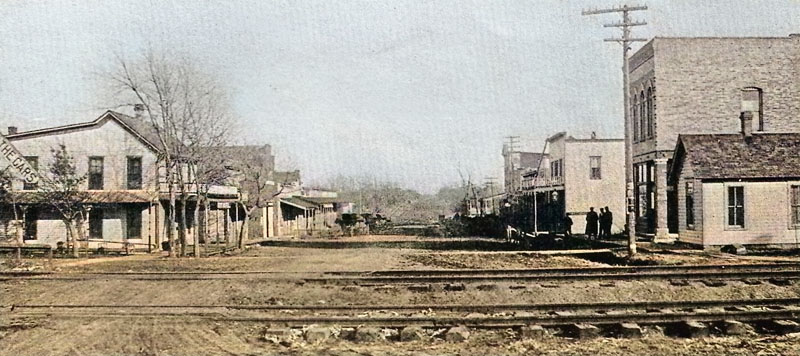
Savonburg, Kansas, in the early 1900s.
A schoolhouse was built in 1889 and enlarged a few years later. The district employed the best teachers obtainable and was consequently reputed to be one of the best-graded schools in the county.
At that time, there were two churches in Savonburg: the Methodist Episcopal, with H.I. Dodson as the pastor, and the Friends’ House of Worship, with L.W. McFarland as the pastor. The members of the Christian church held services at the schoolhouse. The Mt. Moriah Methodist Protestant church was one mile south of town, with James M. Frame as the pastor.
Savonburg was incorporated as a city in 1902, and the Romanesque Revival Savonburg State Bank was established the same year.
In 1910, the community was a station on the Missouri, Kansas & Texas Railroad, had a bank, a weekly newspaper called the Record, a large retail trade, good schools, and nearly all the leading fraternal organizations were represented by lodges. The post office started a money order business with two rural routes. The population in 1910 was 257.
The town’s population peaked in 1920 at 258 and afterward gradually dropped.
On October 31, 1929, two Missouri, Kansas & Texas Railway freight trains collided in Savonburg. Along the single-track railroad, both trains were southbound. One freight train standing at the station was run into by a freight extra train while the latter traveled 43 miles per hour. The accident was caused by the engineman’s failure to read all the orders on the second train, which affected his train’s movement. As a result, his train was moving at a high speed when it approached the station, where the first locomotive was occupying the main track without flag protection. Fortunately, no one was injured.
The Savonburg State Bank failed in 1933 during the Great Depression. Afterward, the building housed the post office and the local Masonic Lodge.
The Savonburg High School closed in 1946, and its grade school closed in the 1960s.
Its post office closed on April 30, 2005.
This village still boasts the active Bible Church at 209 S. Walnut, the City Hall/Library/Community Center at 101 S Walnut Street, several old business buildings, and numerous homes.
Today, the village is served by the Marmaton Valley USD #256 in Moran, Kansas.
Savonburg is located between Fort Scott and Chanute, one mile north of the Neosho County line, about 18 miles from Iola, the county seat.
© Kathy Alexander/Legends of Kansas, October 2024.
Also See:
Allen County, Kansas Extinct Towns
Sources:
Duncan, L. Wallace and Scott, Charles F.; History of Allen and Woodson Counties, Kansas; Iola Registers, Printers and Binders, Iola, KS, 1901.
Blackmar, Frank W.; Kansas: A Cyclopedia of State History, Vol I; Standard Publishing Company, Chicago, IL 1912.
Facebook
Wikipedia

